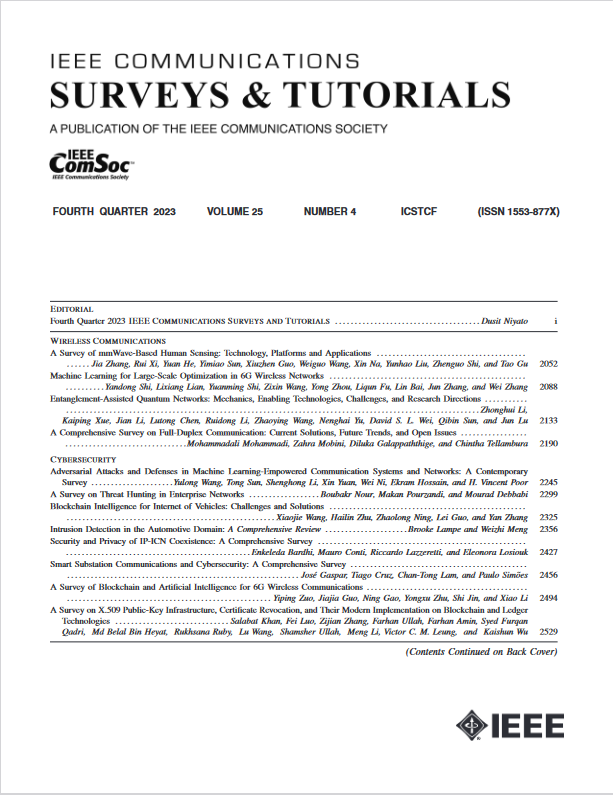Boosting TCP & QUIC Performance in mmWave, Terahertz, and Lightwave Wireless Networks: A Survey
IF 34.4
1区 计算机科学
Q1 COMPUTER SCIENCE, INFORMATION SYSTEMS
引用次数: 1
Abstract
Emerging wireless systems target to provide multi-Gbps data rates for each user, which can be achieved by utilizing ultra-wide channels available at mmWave, terahertz, and lightwave frequencies. In contrast to the traditional spectrum below 6 GHz, these high-frequency bands raise many issues, complicating their usage. For example, because of high signal attenuation and blockage by obstacles, the data rates in a high-frequency band may quickly vary by several orders of magnitude. This peculiarity is often considered a challenge for modern transport layer protocols, such as Transmission Control Protocol (TCP) or Quick UDP Internet Connections (QUIC). Their key component is the Congestion Control Algorithm (CCA), which tries to determine a data sending rate that maximizes throughput and avoids network congestion. Many recent studies show that the performance of the existing CCAs significantly degrades if mobile devices communicate with high-frequency bands and propose some solutions to address this problem. The goal of this survey is twofold. First, we classify the reasons for poor TCP & QUIC performance in high-frequency bands. Second, we comprehensively review the solutions already designed to solve these problems. In contrast to existing studies and reviews that mainly focus on the comparison of various CCAs, we consider solutions working at different layers of the protocol stack, i.e., from the transport layer down to the physical layer, as well as cross-layer solutions. Based on the analysis, we conclude the survey with recommendations on which solutions provide the highest gains in high-frequency bands.在毫米波、太赫兹和光波无线网络中提高TCP和QUIC性能:调查
新兴无线系统的目标是为每个用户提供多gbps的数据速率,这可以通过利用毫米波、太赫兹和光波频率的超宽信道来实现。与6ghz以下的传统频谱相比,这些高频频段带来了许多问题,使其使用复杂化。例如,由于高信号衰减和障碍物阻塞,高频波段的数据速率可能很快变化几个数量级。这种特性通常被认为是对现代传输层协议(如传输控制协议(TCP)或快速UDP Internet连接(QUIC))的挑战。它们的关键组件是拥塞控制算法(CCA),它试图确定最大吞吐量和避免网络拥塞的数据发送速率。最近的许多研究表明,如果移动设备与高频频段通信,现有cca的性能会显著下降,并提出了一些解决方案来解决这一问题。这项调查的目的有两个。首先,我们对高频频段TCP和QUIC性能差的原因进行了分类。其次,我们全面回顾为解决这些问题而设计的解决方案。现有的研究和评论主要集中在各种cca的比较上,与之相反,我们考虑了在协议栈的不同层工作的解决方案,即从传输层到物理层,以及跨层解决方案。在分析的基础上,我们总结了调查,并建议哪些解决方案在高频频段提供最高的增益。
本文章由计算机程序翻译,如有差异,请以英文原文为准。
求助全文
约1分钟内获得全文
求助全文
来源期刊

IEEE Communications Surveys and Tutorials
COMPUTER SCIENCE, INFORMATION SYSTEMS-TELECOMMUNICATIONS
CiteScore
80.20
自引率
2.50%
发文量
84
审稿时长
6 months
期刊介绍:
IEEE Communications Surveys & Tutorials is an online journal published by the IEEE Communications Society for tutorials and surveys covering all aspects of the communications field. Telecommunications technology is progressing at a rapid pace, and the IEEE Communications Society is committed to providing researchers and other professionals the information and tools to stay abreast. IEEE Communications Surveys and Tutorials focuses on integrating and adding understanding to the existing literature on communications, putting results in context. Whether searching for in-depth information about a familiar area or an introduction into a new area, IEEE Communications Surveys & Tutorials aims to be the premier source of peer-reviewed, comprehensive tutorials and surveys, and pointers to further sources. IEEE Communications Surveys & Tutorials publishes only articles exclusively written for IEEE Communications Surveys & Tutorials and go through a rigorous review process before their publication in the quarterly issues.
A tutorial article in the IEEE Communications Surveys & Tutorials should be designed to help the reader to become familiar with and learn something specific about a chosen topic. In contrast, the term survey, as applied here, is defined to mean a survey of the literature. A survey article in IEEE Communications Surveys & Tutorials should provide a comprehensive review of developments in a selected area, covering its development from its inception to its current state and beyond, and illustrating its development through liberal citations from the literature. Both tutorials and surveys should be tutorial in nature and should be written in a style comprehensible to readers outside the specialty of the article.
 求助内容:
求助内容: 应助结果提醒方式:
应助结果提醒方式:


